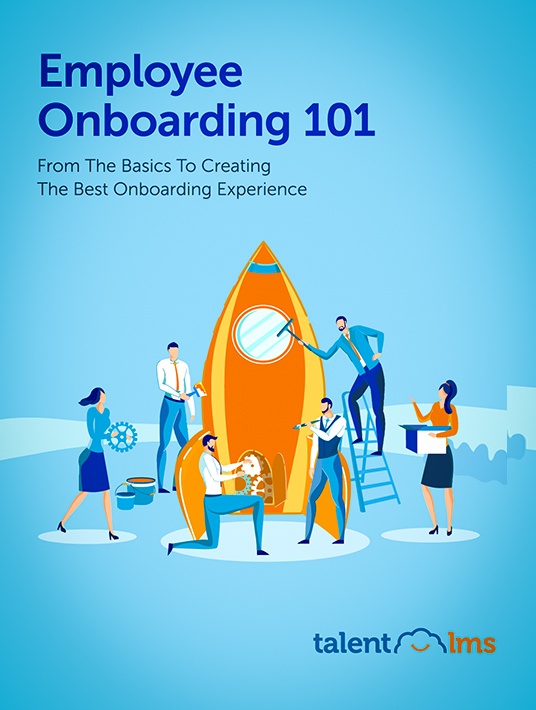The Secrets Of An Effective Onboarding Process
By now, you must have realized that an effective onboarding process is not some fancy process that only large companies should care about. But it is an elaborate one, so most employers fail to get everything right.

Read any onboarding survey available on the internet, and you’ll find that few companies manage to meet employee expectations. What’s happening? Have all employees become hard to please? Because, at the end of the day, all new employees expect from onboarding is to learn how to do their job and fit in with their coworkers.
This chapter focuses on helping you meet these two requirements. It explores the tools you can use to streamline the training process, as well as strategies that will help new employees socialize and adjust to their new work environment.
First Stop: Preboarding
Preboarding refers to the period between the moment an employee accepts your job offer and their first day at work. Like the word itself implies, it precedes onboarding. In reality, preboarding is a few thoughtful gestures that will help the new employee feel noticed and welcome.
One idea is to take the new employee out to lunch with their team. Meeting their coworkers in a less formal environment reduces the awkwardness of the first encounter and the stress of the first day.
Other common preboarding practices include sending a welcome email and an overview of the onboarding program. You can also use your HR software to get some initial paperwork out of the way and send a few getting-to-know-you questions to break the ice.
Preboarding is where employee engagement starts. Sorting things out for employees and welcoming them to the team in advance helps you gain their trust and minimize the chances of them looking for other options.
Create An Onboarding Kit
There’s nothing worse than having a million questions about your new job and not knowing who to ask or what to ask first. This is why offering an onboarding kit is essential. An onboarding kit is mostly an online repository with all the information a new employee needs. You can turn it into something more tangible by additionally offering a small gift.
Usually, you’ll need to include contact information, an office map, and explain basic company policies, the company structure and perks. You can also include information regarding the surrounding area for employees who have relocated.
An onboarding kit is a welcome package and a reference guide at the same time. If you want to make a great impression and give your new employees some peace of mind, this is a must-have.
Pair New Hires With A Mentor
An online repository and a few training sessions are not enough to effectively onboard new employees. It will be a while before they can perform job-related tasks with confidence. And they might feel uncomfortable asking their manager or coworkers for help. Wouldn’t it be more effective if there was a person tasked with guiding new employees through the onboarding process?
Assigning a mentor—also known as an onboarding buddy—is the most effective way to support new employees while they’re still trying to find their way around. A mentor helps the new hire understand how the company works and where their role fits. They also monitor the new employee’s progress, identify their strengths and weaknesses, and give them feedback.
And does mentoring really work? Employees that have been assigned a mentor become productive in their role faster and report higher job satisfaction. Onboarding buddies for the win, then!
Given how important the role of a mentor is, the decision about who this mentor will be should not be taken lightly. An employee with relevant experience and skills is a good choice, but one who shows real enthusiasm for this task is even better. Also, make sure to rearrange their workload accordingly so that they have enough time to dedicate to the new employee.
Get Managers Involved
Imagine arriving at your new job and meeting your manager. They offer you a half-hearted “welcome to the team,” and you don’t see them again for another week.
Would you really feel welcome? Would the person addressing you strike you as a compassionate leader or as another corporate dude? And wouldn’t you start regretting your decision, just a bit? This is not the first impression you want to make.
Managers reflect the company culture and your work ethics more than anyone. They are the most suitable people to discuss the company strategy and get new hires excited about it. Therefore, managers should get involved in the employee onboarding process in small but meaningful ways.
For instance, managers can take on the preboarding process, and send a welcome email or organize a casual lunch with other team members. Later on, in an effective onboarding process, they can check in with the new employee to ask for feedback, discuss concerns, and ensure everything is on track.
Prioritize Job-Specific Over Other Types Of Training
There’s so much a new employee has to learn. They need to know how to do their jobs properly, with all the tools and processes that it entails. They also need to know a bit about cybersecurity because, “Hey, you forgot your password in the kitchen!” And let’s don’t even start about compliance policies, which have only grown in number over the last few years. But do they need to learn everything within their first week or even month? Most definitely not. And, depending on their role or experience, they might need to know more or less about a topic.
A quick introduction to, let’s say, your anti-harassment policy, won’t hurt. It will give new employees a better idea of your company culture, so it’s actually helpful. But training should be most of the time targeted toward job-related competencies. Practicing their new skills with on-the-job training and practical assignments is what will help them become productive and efficient.
Squeezing too much in will inevitably confuse and overwhelm even the most competent employees. Adjust the pace of the training based on the mentor’s feedback, and give the new employee time to adequately process information and establish skills before rushing them to the next training topic.
Use An Effective Onboarding Process To Introduce New Hires To Your Company Culture
Company culture encompasses several notions that are all closely related and interdependent. It refers, among others, to company vision and goals, work ethics, and the energy of the work environment.
Introducing employees to the company culture means helping them acclimate, embrace the company vision, and be excited about working with you. It also means helping them form a connection with the rest of your employees.
Practically, you can conduct a training course where you explain the company strategies and behavioral expectations. But you also have to show actual support and interest, by assigning an onboarding buddy, for example, asking meaningful questions, and being receptive to feedback. Human connection is what will tie everything together and turn your new hires into long-term team members.
Use Employee Onboarding Software
Creating a comprehensive onboarding experience without disrupting your employees’ workflow can be quite a conundrum. By using employee training software, however, you can offer part of the training online and not “steal” employees away from their desks for too long. Your new hires can receive job-specific training in person, and complete nonurgent training online. It’s a good deal, right?
With a full-featured platform, you can add engaging content like videos, branching scenarios, and simulations, and combine different training delivery methods. Gamification, microlearning, and Instructor-Led Training, for example, can all be used to increase learning motivation and offer flexible training options to your newcomers. You’ll also be able to create assessments and access detailed reports to monitor employee progress and identify parts of the training that aren’t working. An LMS is an indispensable tool for companies that need to deploy consistent training on a large scale. Companies with a mobile workforce will also benefit from the use of an LMS with a mobile app, as employees will have access to training on the go and from any device.
Gamify The Onboarding Experience
Gamification usually aims to increase motivation and engagement in the training. New employees must have buckets of motivation, though, so why bother adding points and levels? Why keep score on a leaderboard? It will just make the onboarding process more complicated and less effective, right? Wrong.
Gamification elements can be added to any course without you having to change anything in the content. The only thing that will change is that now, employees will have a way to measure their progress—and get rewarded for it too! And, if anyone needs rewards and encouragement, that’s a new employee.
Gamification doesn’t belong strictly to training courses only; it fits perfectly in the workplace as well. Use gamification to reward proper behaviors and first-time accomplishments. You can create badges for anything, from consistently arriving on time in the morning to landing the first big client. The only limit is your imagination, and common sense. You don’t want employees to feel like gamification is an excuse to monitor their every move.
Take Your Time With It
If employee onboarding sounds like it isn’t a one-week event, it’s because it isn’t. An onboarding program should take at least 90 days to complete. This period concerns mostly job-specific training. Additional types of training and socialization—the latter largely depending on the employee’s personality—can take up to a year.
Onboarding a new employee takes time and patience. Wrapping up the onboarding process too quickly can negate all your efforts. Employees should be introduced to their job roles gradually and systematically, always with the assistance of their mentor, who will increase their workload as they solidify previous knowledge through adequate practice.
Microlearning, and mobile learning for mobile employees, can help extend training without it becoming a disruption. Offering mobile-friendly, bite-sized resources allows new employees to refresh their memory at a moment of need or revisit training when they have free time.
In Conclusion
There are so many points to check off your employee onboarding checklist, but it all boils down to this: onboarding should begin before the employee arrives and end well after the official skills training is over. Skills and competencies can be learned quickly with the help of the right training platform, but adjusting in a new workplace takes longer. To facilitate employee integration, pair newcomers with a mentor and make sure managers are present, showing their support throughout the process. For more tips, download the eBook Employee Onboarding 101: From The Basics To Creating The Best Onboarding Experience.
Editor's Note: Are you looking for more resources to help you streamline your process and prepare your newest team members for the challenges ahead? This guide on how to create an onboarding process is an essential read for HR and L&D pros. It features tips, checklists, and proven strategies for effective employee integration, regardless of your industry. You can also check out this case study to discover how SmartBuyGlasses deploys training for a remote workforce with TalentLMS, including seamless onboarding.










